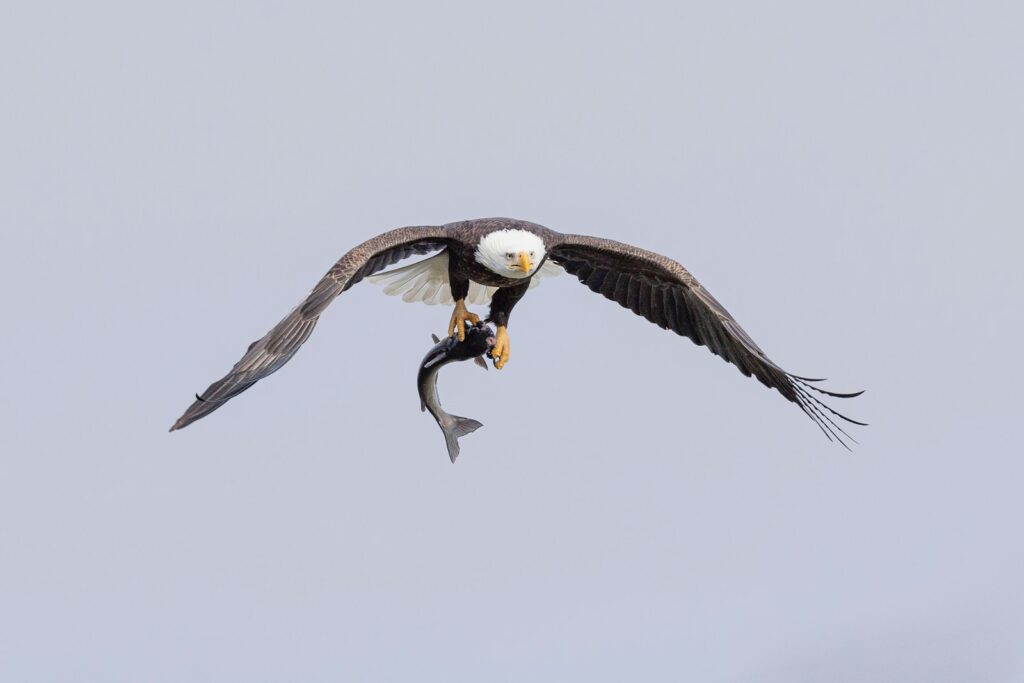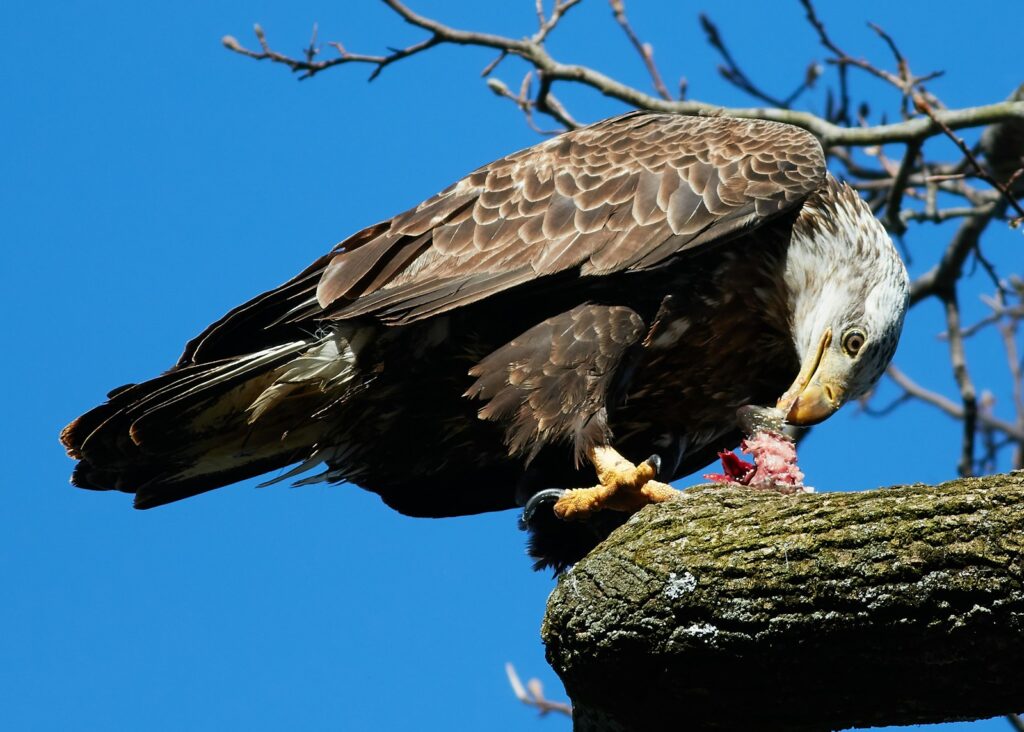The majestic bald eagle, America’s national symbol, evokes images of a powerful predator soaring through the skies before diving dramatically to snatch fish from water surfaces. However, not all bald eagles conform to this noble hunting stereotype. Many regularly engage in food theft, a behavior scientists call kleptoparasitism. This fascinating phenomenon reveals much about eagle intelligence, social dynamics, and evolutionary strategies. While we might expect these apex predators to rely solely on their impressive hunting skills, many eagles have discovered that stealing can be a more efficient survival strategy. This article explores why some bald eagles prefer theft over hunting, the ecological factors that drive this behavior, and what it tells us about these remarkable birds’ adaptive capabilities.
The Energy Economics of Eagle Feeding

Bald eagles, like all animals, operate under the principle of energy efficiency—maximizing caloric intake while minimizing energy expenditure. Hunting is an energy-intensive activity that requires significant physical exertion and carries no guarantee of success. When an eagle dives for fish, it expends considerable energy and risks injury, especially in cold waters where hypothermia becomes a threat if feathers become waterlogged. Studies show that experienced eagles successfully catch fish in only about 10-30% of their hunting attempts, making hunting a relatively inefficient feeding strategy. By comparison, stealing food from another bird or animal that has already done the hard work of hunting can offer a better return on energy investment, especially when opportunities for theft are abundant.
Kleptoparasitism as an Adaptive Behavior

Kleptoparasitism isn’t simply bad behavior—it’s an adaptive strategy that has evolved among many species, including bald eagles. This behavior appears most frequently in environments where resources are concentrated and visible, making theft opportunities more predictable than hunting success. Young eagles in particular benefit from this strategy as they develop their hunting skills over the first four to five years of life. Ornithologists have documented that immature eagles steal food up to 50% more frequently than adults, suggesting kleptoparasitism serves as an important survival bridge during their developmental years. The ability to switch between hunting and stealing as circumstances dictate demonstrates the remarkable behavioral flexibility that has helped bald eagles thrive across diverse environments.
Social Learning and Cultural Transmission

Bald eagles are highly intelligent birds capable of observing and learning from others’ behaviors, including theft techniques. Young eagles often learn kleptoparasitic strategies by watching successful adults steal food from other birds. This social learning creates what some researchers call “local cultures” of food theft among eagle populations in certain areas. In places like the Chilkat Bald Eagle Preserve in Alaska, where thousands of eagles gather during salmon runs, researchers have documented elaborate theft chains, where one eagle steals from another, only to have its prize stolen by a third bird. These complex interactions suggest that kleptoparasitism isn’t merely opportunistic behavior but can become a culturally transmitted feeding strategy within specific eagle communities.
Seasonal Variations in Theft Behavior

The frequency of food theft among bald eagles fluctuates dramatically with seasonal changes and food availability. During salmon runs or when waterfowl concentrate during migrations, eagles gather in unusually high densities, creating perfect conditions for kleptoparasitism to flourish. Research conducted along the Mississippi River found that eagle food theft increased by over 400% during winter months when fish were less accessible due to ice cover, forcing eagles to target other food sources—particularly prey captured by other predators. In the Chesapeake Bay region, scientists have observed that kleptoparasitic behavior peaks during harsh winter conditions when hunting becomes more energetically costly and less productive. These seasonal patterns demonstrate how eagles adaptively shift their feeding strategies in response to changing environmental conditions.
Size and Sex Advantages in Food Theft

Not all bald eagles are equally successful at kleptoparasitism, with physical characteristics playing a significant role in determining which birds employ this strategy most frequently. Female bald eagles, which are typically 25% larger than males, are particularly adept food thieves due to their size advantage. Their greater wingspan (often exceeding seven feet) and heavier weight (up to 14 pounds compared to males’ 10 pounds) make females more intimidating when challenging other birds for food. Research from the Pacific Northwest has documented that female eagles successfully steal food approximately 75% of the time when targeting smaller raptors and about 45% of the time when targeting male eagles. This sexual dimorphism effectively creates different feeding niches within the same species, with larger females more frequently employing theft while smaller, more agile males may rely more heavily on hunting.
Preferred Targets: Who Eagles Steal From

Bald eagles demonstrate clear preferences when selecting victims for their thievery, targeting species that offer the optimal balance of reward versus risk. Osprey are perhaps the most frequent victims, as these fishing specialists are excellent at catching large fish but lack the size and aggression to consistently defend their catches against eagles. Researchers in the Chesapeake Bay documented that a single eagle might steal up to eight fish daily from osprey during peak fishing seasons. Eagles also regularly target each other, with dominant individuals stealing from subordinates, as well as from gulls, cormorants, otters, and even human fishermen. Interestingly, eagles rarely attempt to steal from mammals like wolves or bears due to the substantial risk involved, demonstrating a sophisticated risk assessment capacity when selecting theft targets.
The Cognitive Complexity of Food Stealing

Food theft by bald eagles involves sophisticated cognitive abilities that go well beyond simple opportunism. Eagles must assess multiple variables simultaneously: the value of the potential food item, the capabilities of its current possessor, the presence of competitors, and environmental conditions that might affect the theft attempt. Neurological studies suggest that this complex decision-making activates highly developed portions of the avian brain associated with planning and executive function. Eagles have been observed using diversionary tactics, such as creating disturbances to make other birds drop food, or timing their theft attempts to moments when the target is distracted or vulnerable. These sophisticated strategies indicate that kleptoparasitism requires and potentially enhances cognitive development in eagles, possibly explaining why this behavior is so prevalent in these highly intelligent birds.
Territorial Influence on Theft Behavior

An eagle’s territorial status significantly influences its propensity for kleptoparasitism, creating different feeding strategies between territory-holding birds and “floaters” without established territories. Territory holders typically have reliable food sources within their defended areas and engage in theft less frequently than non-territorial birds. Research in the Pacific Northwest found that territorial adults stole food in only about 5-10% of their feeding events, compared to 30-40% for non-territorial adults and subadults. This difference exists because territory holders can depend on familiar hunting grounds where they’ve developed specialized skills, while floaters must be more opportunistic. During winter congregation periods, these territorial distinctions temporarily break down as eagles gather around abundant food sources, leading to complex social hierarchies based on size, age, and aggression rather than territorial status.
The Impact of Human Activity on Kleptoparasitism

Human activities have dramatically altered the prevalence and patterns of food theft among bald eagles across North America. Fishing operations, dumps, road kill, and hunting waste provide concentrated food sources that attract large numbers of eagles, creating perfect conditions for kleptoparasitism to occur. Eagles gathering at landfills in Alaska have been documented spending more time stealing from each other than searching through trash themselves. Similarly, wildlife viewing areas where eagles are fed for tourist observation have created artificial hot spots for theft behavior. Conservation scientists have noted that in some regions, human-provided food sources have fundamentally altered natural feeding behaviors, potentially making some eagle populations overly dependent on kleptoparasitism rather than developing hunting skills. This human influence demonstrates how quickly eagles can adapt their feeding strategies to exploit new opportunities created by human activity.
Eagle Theft Techniques and Strategies

Bald eagles employ diverse and sophisticated techniques when stealing food, varying their approach based on the target and circumstances. The most common method is the direct aerial attack, where an eagle swoops down on another bird carrying food, forcing it to drop its catch mid-flight. For ground-based theft, eagles use intimidation displays, approaching potential victims with their wings spread wide, head forward, and often vocalizing loudly. Some eagles specialize in “piracy chains,” watching other eagles steal food, then stealing from the thief—a strategy that requires minimal energy expenditure but sophisticated timing. Perhaps most impressive is the collaborative theft occasionally observed among unrelated eagles, where multiple birds will coordinate their approach to overwhelm a food-possessing target, suggesting a level of cooperation previously underappreciated in these typically solitary hunters.
Conservation Implications of Kleptoparasitic Behavior

The prevalence of food theft among bald eagles has significant implications for conservation strategies and population recovery efforts. As eagle populations have rebounded following the ban on DDT and enhanced protection measures, competition for resources has intensified in some regions, potentially increasing kleptoparasitic behavior. Conservation biologists monitoring the recovery of eagles in the Chesapeake Bay watershed have noted that food theft may function as a density-dependent regulatory mechanism, limiting population growth in areas where territories become saturated. Additionally, eagles that become overly reliant on stealing from certain species, particularly osprey, may create conservation challenges for these target species. Wildlife managers must now consider these complex interspecies dynamics when developing management plans, particularly in regions where artificial feeding or unnatural food concentrations might disrupt natural feeding behaviors and population distributions.
Evolutionary Advantages of Behavioral Flexibility

The bald eagle’s ability to switch opportunistically between hunting and stealing represents a prime example of behavioral flexibility that confers significant evolutionary advantages. This adaptability has allowed eagles to survive in diverse habitats from Alaskan wilderness to suburban environments near major cities. Genetic studies suggest that the neurological capacity for this behavioral flexibility evolved during periods of environmental instability in the species’ evolutionary past, when rigid feeding strategies would have led to extinction. The bald eagle’s remarkable recovery from near-extinction in the continental United States—from fewer than 500 breeding pairs in the 1960s to over 10,000 today—demonstrates how this adaptive flexibility enables the species to thrive even in rapidly changing environments. From an evolutionary perspective, kleptoparasitism isn’t a character flaw but a sophisticated adaptation that has contributed significantly to the bald eagle’s long-term success as a species.
Conclusion

Far from being a character deficiency, food theft among bald eagles represents a sophisticated adaptive strategy honed through evolutionary pressures. This behavior showcases the remarkable intelligence and behavioral flexibility that have helped these iconic birds thrive across North America. By opportunistically switching between hunting and stealing based on circumstances, eagles maximize their energy efficiency and survival chances. As we continue to protect and study these magnificent birds, their kleptoparasitic behavior reminds us that even our most revered wildlife symbols don’t always conform to our idealized expectations. Instead, they survive through pragmatic adaptability—a lesson perhaps more valuable than the noble hunting image we often prefer to imagine. The bald eagle’s success story isn’t simply one of power and predatory prowess, but of cognitive sophistication and the ability to exploit every available opportunity in an ever-changing world.

